#tom reisz
Text













Morgan: A Suitable Case for Treatment (Karel Reisz, 1966).
#Morgan: A Suitable Case for Treatment#karel reisz#david warner#vanessa redgrave#larry pizer#tom priestley#victor procter
16 notes
·
View notes
Text
'From Sherlock’s Moriarty to His Dark Materials’ Colonel John Parry; Hamlet to the one-man adaptation of Vanya, Andrew Scott has been a longtime beloved actor of the stage and screen. And now the Dubliner will be taking on another iconic role as he steps into the shoes of Tom Ripley for the upcoming limited series, Ripley. The series, which is based on Patricia Highsmith’s bestselling novels, is set in 1960s New York — and follows Tom Ripley, a grifter who is hired by a wealthy man to go to Italy and try to talk his vagabond son into coming home.
But as Ripley takes the job, he falls headfirst into a life of deceit, fraud and murder.
The cast includes Dakota Fanning, Johnny Flynn, Eliot Sumner, Maurizio Lombardi, Margherita Buy, John Malkovich, Kenneth Lonergan and Ann Cusack.
All eight episodes — which were directed and written by Steven Zaillian — will land on the streaming service on April 4.
The Dubliner told Empire about taking on the role — and the importance of putting “your own stamp” on the character.
He said, “you have to be respectful, but not too reverent, because otherwise there’s no point in doing this.
“You’ve got to put your own stamp on it. Some people will like this version, and some people will like other versions, and that’s okay. What you have to do is understand why this character remains so fascinating for people.”
The Dubliner made his debut on the big screen when he was 17 years old, when he starred in 1995’s Korea opposite Donal Donnelly.
In 1998, he played Edumnd Tyrone in Karel Reisz’s production of Long Day’s Journey Into Night at the Gate Theatre — and was nominated for Best Actor In A Supporting Role at the Irish Times Theatre Award for his role in the show.
Scott had roles in Saving Private Ryan, Nora and the adaptation of Henry James’ The American — and in 2000, he made his stage debut in London with Dublin Carol.
He also appeared in Longitude opposite Michael Gambon, the miniseries Band of Brothers and Dead Bodies.
In 2005, he won his first Olivier Award for his role in the stage show A Girl in a Car with a Man — and made his debut on Broadway the next year, opposite Bill Nighy and Julianne Moore in The Vertical Hour.
Scott starred in the one-man show Sea Wall in 2008 and the next year — and on the screen, he had roles in Little While Lie, Foyle’s War and Lennon Naked, which saw him play Paul McCartney.
And in 2010, he took on the role of Moriarty in the BBC One series Sherlock, which also starred Benedict Cumberbatch and Martin Freeman.
Scott was nominated for a number of awards for his portrayal of the super sleuth’s nemesis, winning the Best Actor in a Supporting Role at the 2012 BAFTAS and Best Actor in a Supporting Role – Television at the 2013 IFTAS.
And in 2013, the actor opened up about the “extraordinary” reaction to the series.
He told The Independent, “Sherlock has changed all our careers, and I’m really pleased about that. It gives you the benefit of the doubt because executives like to see recognisable faces.
“It was overwhelming to be on a TV show that is quite so popular. That took me totally by surprise. People had an instant affection for it from the first episode. The reaction was extraordinary.”
He followed that up with a number of roles on the big and small screen over the next few years, including The Scapegoat, The Stag, The Town and Dates.
In 2014, Scott played Gethin Roberts in the film Pride, for which he was nominated for Best Actor in a Supporting Role at the 2015 IFTAS and won the Best Supporting Actor award at the 2014 British Independent Film Awards.
The same year, he starred in Locke and Jimmy’s Hall. In 2015, he had a role in the 007 film Spectre — and the next year, he had roles in Alice Through The Looking Glass, Denial, This Beautiful Fantastic and Handsome Devil.
In 2017, he played Hamlet on the stage — and was nominated for the Olivier Award for Best Actor in a Leading Role. The stage show was filmed and broadcast the following year.
Scott starred opposite Anthony Hopkins, Emma Thompson and Florence Pugh in 2018’s King Lear — and that summer, it was announced he would be joining the cast of Fleabag.
He captured hearts around the world for his portrayal of The Priest, and was nominated for the Golden Globe for Best Supporting Actor in a Series, Miniseries or Television Film in 2020.
During an appearance on Late Night with Seth Meyers earlier this year, he opened up about being cast in the show — and stepping away from some of the more villainous roles.
He said, “when I was in my 20s, I had a little baby face and I felt like I had this kind of darkness inside me. And I was like ,‘why can’t I get a part as a villain?’
“And then that happened — and then there were loads of villains happening, and I was like, ‘why can’t people see the real me?’
“Phoebe and I had done a play together in London that nobody saw, and she came a knocking — and that’s where the Priest came from.”
The same year, he played Lieutenant Leslie in 1917 and had roles in Black Mirror — which he got an IFTA and Emmy nomination for — and Modern Love.
Scott also took on the role of Colonel John Parry in the BBC’S His Dark Materials, an adaptation of Philip Pullman’s trilogy of the same name. The series ran from 2019 until 2022, and Scott was nominated for Best Supporting Actor (Drama) at the 2021 IFTAS.
On the stage, the actor played Garry Essendine in the revival of Noël Coward’s Present Laughter — and won the Olivier Award for Best Actor. The following year, he played Patrick in The Three Kings.
In 2021, he played Lord Merlin in the three-part adaptation of The Pursuit of Love and Terje Rødlarsen in the film Oslo. The next year, Scott played Lord Rollo in the Lena Dunham-directed comedy Catherine Called Birdy.
Last year, he starred in an adaptation of Vanya which saw him play all of the characters in the show.
He also starred opposite Paul Mescal in All of Us Strangers, which saw him nominated for Best Actor in a Motion Picture Drama at the Golden Globes.'
#Andrew Scott#Ripley#Netflix#Vanya#Paul Mescal#All of Us Strangers#Lord Rollo#Lena Dunham#Lord Merlin#The Pursuit of Love#Terje Rodlarsen#Oslo#Three Kings#Noel Coward#Present Laughter#Hot Priest#Fleabag#Phoebe Waller-Bridge#Moriarty#Sherlock#Hamlet#His Dark Materials#Colonel Jim Parry#Dakota Fanning#Johnny Flynn#Patricia Highsmith#Steven Zaillian#Eliot Sumner#Maurizio Lombardi#Margherita Buy
1 note
·
View note
Text
tag nine (9) people you’d like to know better
tagged by @translouisdpdl <3 sorry this is so late lol tumblr formatting hates me
Last Song: i think it was cupid de locke by the smashing pumpkins bc we were talking about it in the theatres des vampires server lol
Currently Watching: i honestly don't even know anymore, i think the last show i tried seriously watching was the sopranos but it's been well over a month since i did that. i've been watching a lot of dance moms though. as for movies i'm still working through tom cruise summer
Currently Reading: the vampire lestat by anne rice, hangsaman by shirley jackson, and the siren by tiffany reisz
Current Obsession: nicki de lenfent god help me. also tarot
tagging @amyroze @oceanlandworld @julianneinvain @jestertits @dykefagoth @butchybats help finding 9 mutuals to tag is hard i give up
2 notes
·
View notes
Text
Carla Moran, a hard-working single mother, is raped in her bedroom by someone — or something — that she cannot see. Despite skeptical psychiatrists, she is repeatedly attacked by this invisible force. Could this be a case of hysteria or something more horrific?
Credits: TheMovieDb.
Film Cast:
Carla Moran: Barbara Hershey
Phil Sneiderman: Ron Silver
Billy: David Labiosa
Dr. Weber: George Coe
Cindy Nash: Margaret Blye
Dr. Cooley: Jacqueline Brookes
Gene Kraft: Richard Brestoff
George Nash: Michael Alldredge
Joe Mehan: Raymond Singer
Julie: Natasha Ryan
Kim: Melanie Gaffin
Jerry Anderson: Alex Rocco
Mr. Reisz: Sully Boyar
Woody Browne: Tom Stern
Dr. Walcott: Allan Rich
Film Crew:
Director: Sidney J. Furie
Screenplay: Frank De Felitta
Producer: Harold Schneider
Casting: Barbara Claman
Editor: Frank J. Urioste
Production Design: Charles Rosen
Set Decoration: Jerry Wunderlich
Hairstylist: Christine Lee
Makeup Artist: Zoltan Elek
Construction Coordinator: Bruce J. Gfeller
Leadman: Nigel A. Boucher
Set Designer: Daniel Gluck
Set Designer: Boyd Willat
Sound Effects Editor: Keith Stafford
Sound Re-Recording Mixer: Gregg Landaker
Sound Re-Recording Mixer: Steve Maslow
Sound Re-Recording Mixer: Bill Varney
Stunt Coordinator: Chris Howell
Camera Operator: Joe R. Marquette Jr.
Still Photographer: John R. Hamilton
Gaffer: Jon Timothy Evans
Costume Supervisor: Nancy McArdle
Music Editor: Ken Wilhoit
Script Supervisor: H. Bud Otto
Studio Teachers: Arlene Singer-Gross
Unit Publicist: Lyla Foggia
Location Manager: Robert Eggenweiler
Original Music Composer: Charles Bernstein
Director of Photography: Stephen H. Burum
Executive Producer: Michael Leone
Executive Producer: Andrew Pfeffer
Stand In: Marcia Karr
Property Master: Barry Bedig
Sound Mixer: Willie D. Burton
Special Effects Makeup Artist: James Kagel
Special Effects Makeup Artist: Stan Winston
Production Manager: David Salven
Second Assistant Director: William Cosentino
Assistant Property Master: Gene Anderson
Leadman: Frank L. Brown
Construction Foreman: Richard Eckols
Painter: Anthony ‘AJ’ Leonardi Jr.
Paint Coordinator: John Tyrrell
Propmaker: Mark Sparks
Cableman: Robert W. Harris
Boom Operator: Marvin E. Lewis
Special Effects: Martin Bresin
Special Effects: Joe Digaetano
Special Effects: Joe Lombardi
Special Effects: Steve Lombardi
Special Effects: Gary Monak
Special Effects: Robert G. Willard
Special Effects Makeup Artist: Jill Rockow
Visual Effects Designer: William Cruse
Visual Effects Camera: Sam DiMaggio
Visual Effects Production Assistant: Margaret Goldsmith
Visual Effects Production Assistant: Julie Kelly
Visual Effects Production Assistant: Kim Waugh
Stunts: John Ashby
Stunts: Janet Brady
Stunts: Ron Burke
Stunts: William H. Burton Sr.
Stunts: Eddy Donno
Stunts: Kenny Endoso
Stunts: Donna Garrett
Stunts: Buddy Joe Hooker
Stunts: Shawn Howell
Stunts: Tommy J. Huff
Stunts: Linda Jacobs
Stunts: Gary McLarty
Stunts: Ernie F. Orsatti
Stunts: Harry Wowchuk
Grip: Leon Ayres
Grip: Ben Beaird
First Assistant Director: Tommy Thompson
Movie Reviews:
John Chard: Very up and down in its telling of an horrendous story.
This is the loosely based on facts story of Carla Moran, a woman who was allegedly tormented and sexually molested by an invisible demon.
Regardless of if the facts of the case are fictionalised for impact, or if indeed there is any basis of truth to the attacks in question, The Entity as a film fails to rise above average due to sloppy direction and a very poor script, whilst the score from Charles Bernstein is akin to being hit over the head repeatedly with a blunt instrument.
That said, the film isn’t a total wash out, there are genuine moments of dread in the piece, and most of the tension and fear is realised from a very credible performance from Barbara Hershey as Carla. The nature of the beast with this type of picture will always be open to either scoffing or a fear of the unknown, so to get the audience involved with a topic like this you really need your protagonist to be believable, Hershey manages to do this in spite of the character bei...
0 notes
Conversation
Masked Mage: AHHH! GET YO FUCKIN DOG BITCH!
The rest of the party: He don't bite.
Kevin: YES THE FUCK I DO! YOU'LL PAY FOR WHAT YOU DID TO CHARLOTTE!
Masked Mage: *fearful screaming*
#surprised no ones done this yet#can someone do trials of mana as vines?#tom duran#tom hawkeye#tom angela#tom charlotte#tom reisz#tom kevin#incorrect trials of mana quotes#trials of mana#seiken densetsu 3
34 notes
·
View notes
Text
Modern Digimon Dub Rambling
Something that I don’t see brought up with modern Digimon Adventure dubs like... at all is how lackadaisical the dub casting is now?
1. Any voice actors that were still active got to reprise their roles - Colleen O'Shaughnessey as Sora, Mona Marshall as Izzy, Philece Sampler as Mimi, Tom Fhan as Agumon, etc. etc., with the one exception being Doug Erholtz - who apparently couldn’t pull off his TK voice so instead got cast as Daigo in Tri.
2. An effort was made to get back voice actors who haven’t had any roles to their names in years - at least, on sites on IMDB - to reprise their characters as well. So we got roles like Anna Garduno’s Palmon, Jeff Nimoy’s Tentomon, Laura Summer’s Patamon. The consistency even extends to some of the bit characters - Togemon, Birdramon and Angemon retain their actors even though they largely just have battle cries (The latter two were re-cast midway through for unknown reasons) - Beau Billingslea reprises Ogremon in Tri, even though all Ogremon does is grunt.
3. For lack of better place to put this - we know that casting didn’t reach out to actors who had officially retired, including Michael Lindsay, Michael Reisz and Joshua Seth - which is kinda fair- but the former two seemingly would have been interested in reprising had they been notified, and Joshua Seth had to reach out himself in order to reprise his role as Tai.
That all said, it’s clear whoever was in charge of casting made very deliberate decisions to retain as much former cast as possible even to surprising ends, to the point of getting back actors who had dropped out anime VA work. So it feels like whoever is casting has a pretty good knowledge about Digimon... until randomly, they don’t?
Several characters have new voices that feel like they couldn’t have possibly come from the way we knew them in the original Adventure and 02′s dubs. Joe, Kari and Davis have noticeably higher voices in their college years than they did when they were twelve. Gatomon’s original voice had catlike qualities to it, while her Japanese voice had one that made her sound more mature than the other Digimon, but Tri/Kizuna’s dub casts aside both of those and just goes for a ‘kinda cute‘ voice.
Brian Donovan and Neil Kaplan were set to reprise Davis and Hawkmon respectively before Covid complications made that impossible, and only Hawkmon’s new VA emulated the original actor while Davis’s new actor didn’t bring any of Donovan’s unique performance, so every line with Davis is noticeably, distractingly different.
Philece Sampler and Laura Summer don’t reprise Koromon or Tokomon despite already being cast in said dubs, and instead the two are played by men, which means they now have deeper voices than their immediate evolutions (and Tokomon just flat out has Gomamon’s voice).
And poor Armadillomon - somehow the casting director was aware of Hawkmon’s accent but not Armadillomon’s, so instead of a western accent - which should be extremely easy to replicate in some way - Armadillomon has this bizarre squeaky toy voice.
And lastly there’s Vic Mignogna as Matt - a completely baffling, unfitting casting decision until you realize that Tri’s Matt is literally just written as Digimon Fusion’s Christopher Aonuma, so it’s actually just a stealth reprisal and they clearly just wanted to protect Michael Reisz from such a horrible character assassination. (Hilariously enough, Nicolas Roye plays Matt much closer to Reisz’s portrayal than Mignogna’s, so puberty really did a number on Matt.)
This isn’t an attack on any of the actors or anything - even if there’s casting decisions I really don’t care for, everyone does a good job and in a vacuum I can see why they were cast (Except for Armadillomon - there’s no excuse for that). I just genuinely don’t think I’ve seen such a weird approach to casting before - get as much a original cast back so they sound like what fans know and love, and then cast everyone else without regard to the original dub or sub, throwing a dart to cast Tokomon and Koromon for good measure.
Since characters like Mimi (who’s replacement in Kizuna sounded nothing like Sampler) and Matt show they don’t entirely care about consistency, I hope they’ll bring back Donovan for what may be Davis’s last run in the new movie at least.
#Digimon#Digimon Adventure#Digimon Adventure 02#Digimon Adventure Tri#digimon adventure last evolution kizuna#Kingdom Contemplations
19 notes
·
View notes
Photo

Uncanny X-Men Vol. 1 No. 279 (1991) Part of the "Muir Island Saga" event Synopsis for "Bad to the Bone (Muir Island Saga, Pt. 2)" Under the mental control of the Shadow King, Colossus chases Xavier and Stevie Hunter through the ruins of the Xavier Institute. It comes to a showdown between Xavier and the Shadow King in the Danger Room, and Xavier realizes that he can only free Colossus by destroying the artist Peter Nicholas personality in Colossus head; though it hurts him as Piotr actually was happy as an artist. On Muir Island, only Forge remained free from the Shadow King’s influence and the other X-Men are hunting him. Yet Forge is able to use a neurosynaptic scrambler on Wolverine and when being discovered by Rogue, he knocks her unconscious with a gun. The Shadow King realizes that he needs a new host body, as that of FBI agent Jacob Reisz is beginning to deteriorate. Xavier, Stevie and Colossus witness a riot in Salem Center which is actually the Shadow King’s doing, they decide to call in X-Factor. Published: August, 1991 Editor-in-Chief Tom DeFalco Cover Artist Andy Kubert Scott Williams Rick Parker Writer Chris Claremont Jim Lee Fabian Nicieza Penciler Andy Kubert Inker Scott Williams Colorist Glynis Oliver Letterer Lois Buhalis Tom Orzechowski Tomoko Saito Editor Bob Harras Suzanne Gaffney #thecomicsofsolitude #comicsofsolitude #comicbooks #comicbook #comic #comics #marvelcomics #dccomics #actioncomics #marvel #marvelstudios #marvellegends #marveluniverse #stanlee #dc #dcuniverse #dcextendeduniverse #dcfans #marvelfans #actionfigures #instagood #themanofsteel #superman #love #xmen #cosplay #cosplayer #uncannyxmen #superhero https://www.instagram.com/p/CQ2eAVls1ww/?utm_medium=tumblr
#thecomicsofsolitude#comicsofsolitude#comicbooks#comicbook#comic#comics#marvelcomics#dccomics#actioncomics#marvel#marvelstudios#marvellegends#marveluniverse#stanlee#dc#dcuniverse#dcextendeduniverse#dcfans#marvelfans#actionfigures#instagood#themanofsteel#superman#love#xmen#cosplay#cosplayer#uncannyxmen#superhero
2 notes
·
View notes
Text
Remembering Albert Finney by Susan King
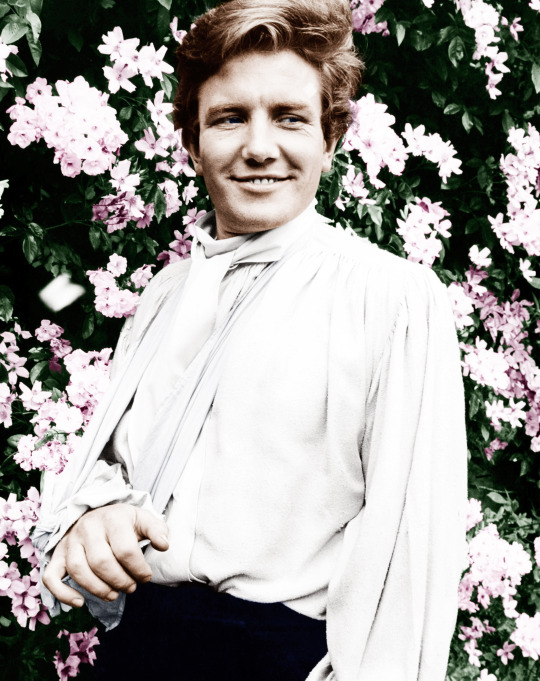
Albert Finney, who died in February 2019 at the age of 82, may have been an acclaimed Hollywood star, but he never played the Hollywood game.
When I had the great and good fortune to interview him 20 years ago for the Los Angeles Times, the charming Finney explained why he didn’t leave England behind and move to La La Land when 1963’s Oscar-winning TOM JONES made him an international star.
“I felt after TOM and TWO FOR THE ROAD (’67), I didn’t want to go shackle myself with any sense or idea that I was a movie star,” he noted. “I wanted to go any way that I wanted to go, and I wanted the freedom to do it.”
And he always stuck by his guns.
Finney earned five Oscar nominations—TOM JONES, MURDER ON THE ORIENT EXPRESS (’74), THE DRESSER (’83), UNDER THE VOLCANO (’84) and ERIN BROCKOVICH (2000)—but he never attended an Oscar ceremony.
After enduring a long screen test for David Lean’s Oscar-winning 1962 epic LAWRENCE OF ARABIA, Finney turned down the title role because he didn’t want to be tied to a five-year contract with the film’s veteran producer Sam Spiegel. According to Finney’s biographer, Quentin Falk in his 1992 book Albert Finney In Character, the actor told Spiegel, “I don’t know where I want to be in five years’ time – or tomorrow for that matter.”
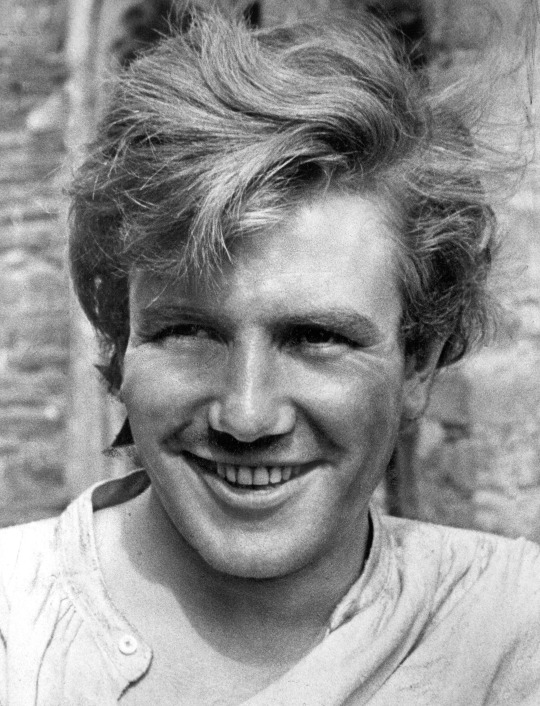
He even turned down a chance in 2000 to be knighted because he said such honors were a way of “perpetuating snobbery.”
Falk noted that Finney was barely 20 when theater critics hailed him as the new Laurence Olivier: “Yet instead of pursuing either mantle, he became a millionaire.” Finney took profit points on TOM JONES “and made love to beautiful women on several continents.”
Adding, “To some he is still the leading actor of his generation; to others, though, he has suffered an ambition bypass. To even severer critics, he appears to have remained cheerfully indolent, an almost willing failing to fulfill the remarkable early promise.”
I beg to differ. He may not have made a plethora of movies and those he did weren’t always gems, but he was always fascinating to watch.
Finney was one of several acclaimed performers known as the “angry young men,” including Alan Bates, Michael Caine, Tom Courtenay and Terence Stamp, who came to fame in theater and movies in the 1950s and early ‘60s in the British “kitchen sink” dramas made famous in 1956 with John Osborne’s play Look Back in Anger, directed by Tony Richardson for film in 1959.
Finney earned a BAFTA for best actor for his first starring role in the dour, gritty 1960 drama SATURDAY NIGHT AND SUNDAY MORNING, directed by Karel Reisz and produced by Richardson.
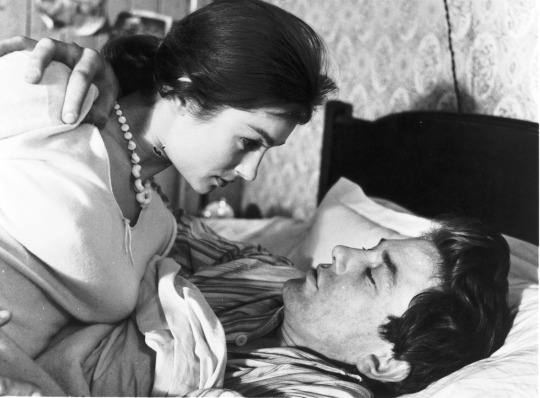
Though some contemporary critics believe the film may be dated, there’s no denying Finney’s star-making performance as Arthur Seaton, a young man working in a bike factory in Nottingham who spends his off-hours drinking in the pubs while carrying on an affair with a married woman (Rachel Roberts) as he also romances a young woman (Shirley Anne Field).
Then came TOM JONES, a rollicking, sexy romp directed by Richardson and penned by Osborne from Henry Fielding’s classic novel in which Finney played the sexiest of rogues. Finney earned his first Oscar nomination for his flawlessly funny and, well, hot performance and the film went on to receive four Oscars including Best Film, Director and Screenplay.
But instead of cashing in on the success of TOM JONES, Finney traveled for nearly a year and then resurfaced in the rarely seen 1964 thriller NIGHT MUST FALL, based on Emlyn Williams hit play. Directed by Reisz, Finney is fine as Danny, a charming young man who is actually an axe murderer who keeps a head in a hat box. But the film just didn’t come together, and it was axed by critics and audiences.
My favorite Finney film is 1967’s TWO FOR THE ROAD, an exceptional romantic comedy drama that explores a decade in the life of a married couple (Finney and Audrey Hepburn). Penned by Frederic Raphael, directed by Stanley Donen and featuring a haunting score by Henry Mancini, TWO FOR THE ROAD is seductive, romantic and sophisticated. Finney and Hepburn have chemistry to spare and for good reason; the two fell in love while making the film.
Finney seemed to have a lot of fun as Dickens’ Ebenezer Scrooge in the hit 1970 musical SCROOGE, and he then earned his second Oscar nomination for his deliciously eccentric turn as Agatha Christie’s rotund Belgian sleuth in Hercule Poirot in Sidney Lumet’s stylish 1974 MURDER ON THE ORIENT EXPRESS.
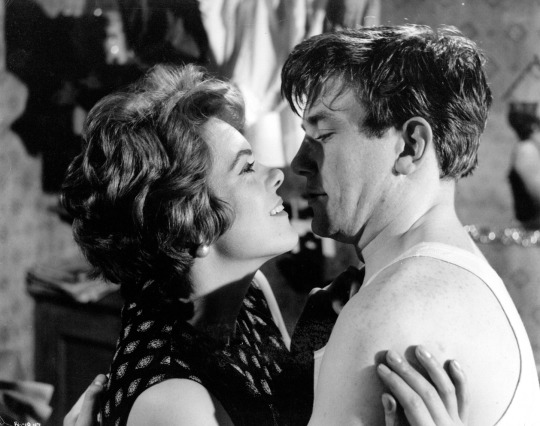
But for most of the 1970s, he concentrated on theater. From 1972-75, he directed plays at the Royal Court Theatre where he was an artistic director, and from 1975 he appeared in several plays at the National Theatre.
The only time I ever saw Finney on a TV chat show was during this time in 1977, when he recorded an album for Motown of all labels, Albert Finney’s Album, for which he wrote the songs. The disc was soon relegated to the bargain bins.
Finney returned to films full force in the 1980s, most notably playing Daddy Warbucks in John Huston’s lavish and laborious 1982 musical ANNIE, as well as in Peter Yates’ THE DRESSER, for which he received his third Oscar nomination, as an aging, hammy stage actor whose dresser (Tom Courtenay) tries to keep the actor’s life and career from falling into disarray.
My favorite Finney performance is in Huston’s UNDER THE VOLCANO (’84), based on Malcolm Lowry’s semi-autobiographical novel. He earned his fourth lead actor nomination for his naked, heart-wrenching performance as an alcoholic former British consul in a small Mexican town on the Day of the Dead in 1938. It’s a performance that will be seared in your memory for a long time.
Finney began the 21st century on a high note with his Oscar-nominated turn as the caring lawyer boss of ERIN BROCKOVICH (Julia Roberts) in Steven Soderbergh’s smart 2000 drama. Two years later, he picked up a BAFTA and Emmy for his full-blooded turn as Winston Churchill in the HBO film THE GATHERING STORM. Of course, he didn’t attend the Emmy ceremony.

He disappeared from view in 2007, returning five years later in THE BOURNE LEGACY and the James Bond blockbuster SKYFALL. He took time away from acting due to his battle of kidney cancer. SKYFALL ended up being his last film and he stole every scene from under the nose of 007 himself, Daniel Craig.
I still remember him sitting at a small table on the patio at the posh Santa Monica hotel Shutters, talking to me in the late afternoon over a cup of coffee. There were no airs with Finney. He was still a working-class guy who just happened to be one of the greatest actors around.
I asked him what it was like to work in films and TV in England in the 1960s.
“It was [a creative time],” he replied. “At that time, we thought, that’s how it is. You don’t realize in the time that it was a very special time. In the 1950s, suddenly novelists started to write about ordinary people in a way that hadn’t been written about before. Then dramatists did, and then there were performers who played those people, and then there were the Beatles. Things became possible for people that hadn’t seemed possible before.”
80 notes
·
View notes
Text
Mirror, Mirror: When Movie Characters Look Back at Themselves by Sheila O’Malley

“I always feel it behind me. It’s myself. And I follow me. In silence. But I can hear it. Yes, sometimes it’s like I’m chasing myself. I want to escape from myself. But I can’t!” —Peter Lorre as child-murderer, M (1931)
There was a period in the ‘60s and ‘70s when you could barely call yourself a male movie star if you didn’t do a scene where you stared at yourself in the mirror, doing various “private” things. The device shows up before then, too, but the floodgates opened in the ‘60s and ‘70s. Meryl Streep has observed, “Often the scenes that are the most exciting, and most illuminating in film, are the ones with no dialogue…where a character is doing something alone, where the deepest most private self is revealed or explored. Exposed.”
Mirrors have multiple thematic uses (as well as the obvious directorial choice to add visual interest to the frame). But if a character is inarticulate, then seeing him “deal with” his reflection can fill in some gaps. It’s a great storytelling shortcut. If the character has a firm public “mask,” a “mirror scene” can let us see who he is when no one is watching. We all lie, to some degree, out there in the world (or on social media). We construct a “self” and a mirror scene allows the character to strip that away.
Speaking stereotypically (or, in archetypes), what is expected of male characters in terms of public persona is different from the pressures on female characters. Not better or worse, just different. Crying, showing uncertainty, weakness, vulnerability … can be a minefield. This is why the glut of male mirror scenes in the 70s makes a kind of sense: as the women’s movement rose, men began to wonder about their place, as well as buck against some of the gender norms imposed on them (or, in some cases, re-entrench said gender norms, Travis Bickle’s “You talkin’ to me” the most classic example).
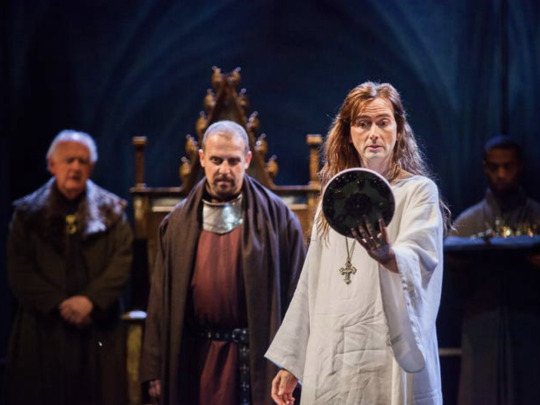
Shakespeare’s use of the soliloquy—in particular for Kings and prospective Kings—could be seen as mirror scenes, with the audience as the mirror. A man goes into a private space, showing the audience things he cannot show on the battlefield or in the court. Hamlet, one of the most introverted of Shakespeare’s characters, showing non-gender-norm qualities of uncertainty and sensitivity, has a massive six soliloquies. (“O that this too too solid flesh would melt”, “O what a rogue and peasant slave am I”, “To be or not to be”, “Tis now the very witching time of night”, “Now might I do it pat” and “How all occasions do inform against me.”) It is impossible to imagine the play—or Hamlet—without them. In Richard II, after Richard is forced to surrender his crown, what is the first thing he does? Like a true narcissist, he calls for a mirror. As he stares at himself, he wonders,
“Was this face the face
That every day under his household roof
Did keep ten thousand men?”
and throws the mirror on the ground.
Mirrors are powerful and mysterious symbols. The doubling-up can mean all kinds of things. Alice steps through the looking glass into another world. Goethe’s Faust looks into the witch’s mirror and sees a beautiful woman staring back. Dorian Gray takes a mirror to compare his face with the one in the attic portrait. (Like Richard III, Dorian smashes the mirror.) A mirror is crucial in Tennyson’s “The Lady of Shalott,” where “The Lady” is cursed to view the world only through a mirror. But then Lancelot rides by and she can’t help it, she has to sneak a peek. Maybe the most famous fictional mirror is the Evil Queen’s in “Snow White,” the one she asks every day, “Mirror, mirror, on the wall, who’s the fairest of them all?” Richard III doesn’t look for a reflection of his beauty. He wonders where his “self” even is, without the crown.
An early male mirror scene—and one of the best—is Peter Lorre’s in Fritz Lang’s M (1931). Our first glimpse of Lorre’s face comes without warning. As a handwriting-analyst theorizes in voiceover about the child-killer’s psychology, we see him, staring at himself in the mirror. He pulls at his face, slowly, manipulating his mouth into a smile, trying it on for size, maybe seeing what it looks like to the children he seduces. He bugs his eyes out, turning this way, that, a maniacal presence, almost like a shark rolling its eyes backwards as it attacks. He has no sense of what human beings feel like, of what he looks like, of how to even make a facial expression. It’s one of the most chilling private moments in cinema.

Speaking of “private moments”: Constantin Stanislavski wrote a lot about how actors needed to feel “solitude in public.” He wrote: ”During a performance, before an audience of thousands, you can always enclose yourself in this circle…You can carry it with you wherever you go.” Lee Strasberg developed his “private moment exercise” to help actors achieve “solitude in public.” There are things you do when you are alone which you would stop doing if someone walked in. Maybe you sing along to the radio. Maybe you talk to yourself. Maybe you pick your nose. Maybe you do all of these things simultaneously. Our “public” selves are drilled into us from a very young age. There are “good manners,” there are “contexts” to be memorized—what flies at home will not fly outside the home. Breaking down the public face, letting an audience see who you are when you are by yourself, is part of the actor’s job. (It’s not a surprise that the '70s came to be dominated by private-moment mirror scenes, considering the influence of the Strasberg method on acting styles.)
One of the most important mirror scenes, and a huge influence on Martin Scorsese, is Marlon Brando’s in Reflections in a Golden Eye, directed by John Huston. Brando plays Major Weldon Penderton, a closeted gay man married to a frustrated, luscious Elizabeth Taylor. Late at night, Penderton sits alone, staring at pictures of naked male statues from Greek antiquity. The character lives in an almost totally male world (the military), turned on by young soldiers, and terrified of revealing himself. In one scene, alone downstairs in the house, he walks into the hall and stares at himself in the mirror. After a moment of vacuity, he begins to talk to himself, or, more vulnerably, to an imaginary other person. He pretends to respond to what the other person says, he practices laughing, and he smiles, but the smile is superimposed. He can’t get it to look real. What he says is a kind of murmur, a “pretense” of conversation. This is the kind of vulnerability Brando could achieve like no other. Without this scene, the Major could have been a caricature. All we see is his fuddy-duddy sexless stiff public mask. The mirror scene shows his confusion at how to be a man, how to navigate even a casual conversation.

Alain Delon has a stunning mirror moment in Purple Noon (1960), Rene Clement’s adaptation of Patricia Highsmith’s The Talented Mr. Ripley. Delon plays the sociopath Tom Ripley, in thrall to his casually masculine friend Philippe Greenleaf (Maurice Ronet). Delon’s chilly presence onscreen works to beautiful effect: He doesn’t show us much. But then, he tries on Philippe’s clothes, a sleek pinstripe jacket, fancy shoes. He checks himself out in the mirror. Most actors would leave it at that. But Delon understood the homoerotic implications of the script, not to mention the character’s dangerous narcissism. Delon leans into the mirror and gives himself a rapturous long kiss, slitting his eyes open at one point, to check out what he looks like.
It’s interesting to contrast this with the same scene in the 1999 adaptation, The Talented Mr. Ripley, starring Matt Damon. Director Anthony Minghella makes the subtext practically text, by placing mirrors in almost every scene (the final shot of Ripley is through a mirror). When Ripley tries on his friend’s clothes, he dances around to Bing Crosby’s “May I,” doing a vaudeville burlesque. It’s a different kind of rapture than Delon’s swooning kiss. Damon’s drag-style dance is more for the audience, an explicit display of inner gay-ness, what Ripley is hiding beneath his good-natured submissive public persona. It’s a good scene, although I prefer Delon’s. Delon’s kiss is Stanislavsky’s “public solitude”—and it shows the terrifying void within the character. There is no self. The entire world is a mirror.
In Karel Reisz’s gritty Saturday Night and Sunday Morning, Albert Finney’s Arthur, in a whirl of work, sex, and alcohol, is suddenly caught by his reflection one hungover morning. He was beat up the night before. He plays at being a sniper through his window, targeting local women with pellets. It’s a thin line between playfulness and murderous acting-out. Finney digs into this aspect of the character when he suddenly speaks to his reflection. It is a statement of bravado before descending into confusion: ”I’m me and nobody else. Whatever people say I am that’s what I am not, because they don’t know a bloody thing about me. God knows what I am.”
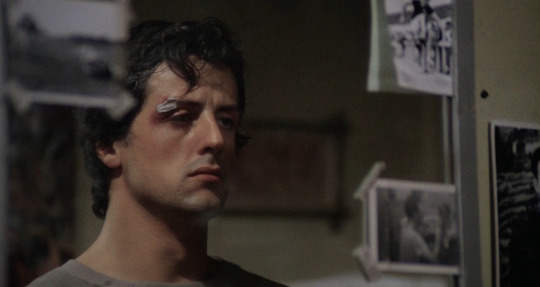
For the opening sequences of Rocky, we see Rocky Balboa’s normal “day in the life.” We are introduced to him through various public selves. But when he goes home to his dank apartment, feeding his turtles, gentle and quiet, his loneliness is so acute it reverbs off the screen. Childhood photographs of him line the mirror frame, and Rocky stares at them, his big-lug face almost crushed in disappointment. Holding a container of turtle food, he starts to talk to himself. What he’s saying doesn’t sound like anything, just private-moment murmurings, but in the next scene, when he goes to visit the girl in the pet store, it becomes clear. He was practicing a joke to tell her, a joke designed to make her laugh, show her he’s a safe person, he’s nice. Rocky practicing a joke in the mirror is one of Stallone’s most vulnerable moments as an actor (and evidence of his gift as a screenwriter).
John Travolta’s mirror moment in 1977’s Saturday Night Fever is star-making, not just because of Travolta’s almost otherworldly gorgeousness (as well as how he revels in said gorgeousness, behavior considered coded-female). Surrounded by 1970s icons—posters of Rocky, Serpico, and Farrah Fawcett—he blow-dries his hair, places gold chains around his neck, and stands like a superhero in his black speedo briefs, shot from below. Perhaps the most revealing thing about the scene is that when his father barges into the room, Travolta’s Tony Manero does not stop what he is doing. His lack of embarrassment tells us everything we need to know about the character.
Francis Ford Coppola’s epic, Apocalypse Now begins with a hallucinatory sequence showing a PTSD-rattled Martin Sheen, holed up in a hotel room in Saigon, tormented by memories. In one shocking moment, Sheen stands unsteadily, and lurches around in front of the mirror, flailing his arms out in imitation martial-arts moves, an attempt to combat his helplessness and anguish, his impotence. But the gap between reality and fantasy is too great, and he, like Richard III, smashes the mirror.
Richard Gere’s mirror moment in American Gigolo is a distant cousin of John Travolta’s. His Julian has carefully crafted an immaculate persona for his female clients, and part of the movie’s pull is watching it get stripped away. At home, Julian wanders around, practicing Swedish, working out, picking out clothes for his next appointment. He’s vain, but vanity is part of his job. Smokey Robinson’s “The Love I Saw In You Was Just a Mirage,” and it’s perfect because Julian literally is a mirage. To his clients, to himself, even. When he stands in front of the mirror, flexing his muscles, he is more Evil Queen than Richard III, a destabilizing of gender norms around male sexuality (and self-presentation) which is so much a part of the film. (When Julian meets a private detective, it’s at a joint called the Me & Me Coffee Shop. Julian’s hall of mirrors shatters by the end of American Gigolo: in the final scene, he talks to Lauren Hutton through a glass partition in prison. The mirror is no more. He can see through it now to the other person, and, crucially, he can be seen, too, as he really is.)
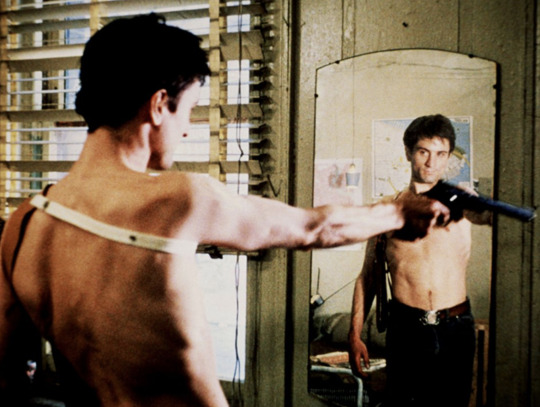
The most famous mirror moment is, of course, Robert De Niro’s in Taxi Driver. In the insomniac voiceover, his Travis Bickle says, “I think that someone should become a person like other people,” showing the character’s alienation from other humans. You aren’t already a person, to Travis: you have to become one. As Travis descends into psychosis, dreaming of 1. impressing the cool blonde (Cybill Shepherd) who rejected him after he took her to a porn movie on their first date and 2. rescuing the child prostitute Iris (Jodie Foster), he begins to amass a small arsenal, putting together boot holsters and straps to go around his wiry body. In the unforgettable moment when he checks himself out in the mirror, he goes into a zone of macho fantasy. (Schrader’s script said only “Travis speaks to himself in the mirror.” De Niro’s “You talkin’ to me” was his improvisation.) De Niro goes so far into his sense of privacy, it’s almost embarrassing to watch. And yet it’s so human, too. (If you say you’ve never talked to yourself in the mirror, or sung in the shower, you’re lying.)
De Niro’s second mirror moment is Raging Bull’s final scene, when the bloated Jake La Motta recites Marlon Brando’s “I coulda been a contender” monologue from On the Waterfront, before standing up and doing a series of “pumping up” exercises, to get ready to go onstage. (Side note: Mary Elizabeth Winstead closes out Eva Vives’ wonderful 2018 film All About Nina, about a troubled stand-up comic, with a re-creation of the scene from Raging Bull.) What’s fascinating about the Raging Bull scene is that Jake La Motta has no “self” to reveal. It’s almost like there’s no inner life at all. He doesn’t “get it.” He never did, he never will. De Niro blanks himself out in a very unnerving way, opposite to the dangerous vengeful-spirit fantasy he inhabits in Taxi Driver.
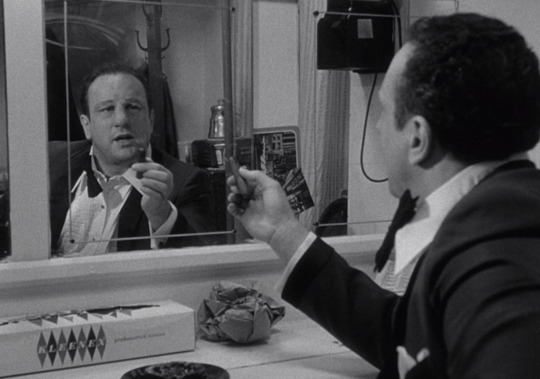
Although Walter Hill’s Johnny Handsome descends into a cliched crime movie with paper-thin characters, the opening sequences are dark, cynical, and atmospheric. Mickey Rourke plays Johnny, a man with a deformed head, an “ugly” appearance which has separated him from other humans. Reminiscent of the Joan Crawford film A Woman’s Face, a caring plastic surgeon (Forest Whittaker) offers to operate on Johnny, to give him a chance at a new life. When Rourke unwraps the bandages and sees his new face (i.e. Rourke’s real face), Rourke has a mirror moment like almost no other, a moment worthy to be placed alongside Brando’s and De Niro’s. He touches his face with wonder, bursting into tears. That’s touching enough, but then, as he glances back at Whitaker, Rourke goes deeper. A look of fear, and lifelong anguish floods his eyes, as he says, “I feel like I still have a mask on” and then, after that, Rourke goes even deeper into a maelstrom of emotion: gratitude, bafflement, awe, despair. The scene is Rourke’s finest hour.
Up until recently (with a couple of exceptions), when women stared at themselves in the mirror in the movies, it was obvious what they are doing: touching up their makeup, checking out their mask. Once again, in the 1960s and 70s, women started doing “mirror scenes” equivalent to men’s mirror scenes, where the purpose was not perfecting the public mask, but to - as Sylvia Plath wrote in her poem “Mirror” - search “my reaches for what she really is.” Faye Dunaway has a great one in Jerry Schatzberg’s Puzzle of a Downfall Child. Gena Rowlands has quite a few “mirror scenes” in the movies she did with Cassavetes (there’s a couple of stunners in Opening Night). In my favorite moment in Sofia Coppola’s The Bling Ring, after breaking into Paris Hilton’s house, Katie Chang goes into a daze of mad-woman fantasy, staring at herself in Paris’ mirror. It’s not hard to imagine the character slipping into the Manson family, if a Manson came along. She’s as blank as Jake La Motta. In La Verite’s opening scene, Brigitte Bardot stares at her face in a broken shard of a mirror, right before marching off for her court date. Her “self” is fragmented, broken. Jennifer Jason Leigh has an extraordinary extended “mirror scene” in Georgia. The moment is everything: self-hatred, rage, searching and longing, and bone-deep narcissism.

Men staring at themselves in the mirror let us into their secret worlds, their fantasies and anxieties, uncertainties and vulnerabilities. It’s not about being self-obsessed. It’s trying to find the self, the self that is not allowed free rein, be it a benign self or a malevolent one.
In Caravaggio’s “Narcissus,” Narcissus leans towards his reflection in the water, his posture pulled downwards with a seductive tug. He braces himself by his hands on the ground, and his knee, bulging out beneath his torso, is the only barrier between Narcissus and his reflection (and, perhaps, drowning). In the painting the reflection below is cut off; all we see are the forearms and that gleaming sturdy knee. Even though Narcissus’ body is barely visible, even though he’s hunched over himself, his energy is childlike, soft and open. He gives his reflection a caressing stare, a swooning look. He yields. This is not just vanity. This is something else.

#musings#film writing#film essay#oscilloscope laboratories#beastie boys#adam yauch#independent film#mirror#taxi driver#robert de niro#Martin Scorsese#american gigolo#fritz lang m#peter lorre#the bling ring#sofia coppola#shakespeare#richard ii#saturday night fever#john travolta#rocky#sylvester stallone#gena rowlands#faye dunaway#marlon brando#reflections in a golden eye#raging bull#jake lamotta#johnny handsome#mickey rourke
43 notes
·
View notes
Text
fiction recs (obscure):
-cold tom, sally prue. fairies done right. incredibly rare, incredibly good.
-unleashed, kristopher reisz. werewolves done adequately. also quite rare. for more adequate werewolf content, see holly black's short story 'the dog king'.
-above, leah bobet. mutant/magical-being outcasts live in underground hideout but then there are events and they have to fight enemies and stuff. w/e, cool world, exciting plot, complex characters i think.
-things not seen, andrew clements. boy turns invisible one day, it's p neat. (the sequels aren’t as good though).
-stoneheart trilogy, charlie fletcher. boy gets stuck in overlapping version of city where statues are alive, has to deal with hostiles and other problems. there's also a girl, she's really cool, they do not iirc do any romance (a plus).
-(don't you) forget about me, kate karyus quin. small town makes its members immortal, gives kids superpowers which they typically use to do lots of murders. dreamy and gentle, iirc.
-the game of sunken places, mt anderson, and to a lesser extent its sequels. the nonhuman characters are really cool and it's a fun adventure.
-the moorchild, eloise mcgraw. another example of fairies done right.
-teeth, hannah moskowitz. i found this incredibly disappointing because i mistook a preview of a different book for the ending when i skipped to that and it consequently looked way cooler than it actually is, but it does have a mermaid character who is iirc quite a bit better than average.
-cuckoo song, frances hardinge. another decent changeling story.
-the brief history of the dead, kevin brockmeier. gentle apocalypse combined w/ nice quiet afterlife (temporary). endings, but in a soft way.
-the necessary grace to fall, gina ochsner. short stories, magical realism or whatever. i found the writing a bit hard to get through but there are lots of pretty bits and the concepts themselves are pretty also.
-surrender, sonya hartnett. guy reflects on his boyhood and the shitty things he and his friend did. really pretty writing.
-attolia series, megan whalen turner. low-magic high fantasy setting (worldbuilding is good), political intrigue, a remotely compelling straight relationship.
less-obscure recs may arrive someday but not soon
#recs#disclaimer it's been ages since i've read some of these#this list is neither ordered nor complete#doctrine of labyrinths—a great series—has a similar number of goodreads reviews to these but i feel like it is nonobscure despite this#maybe it just comes up on recommendation lists a lot#post was written ages ago but w/e
10 notes
·
View notes
Photo
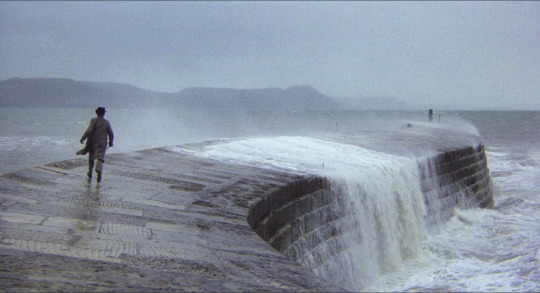

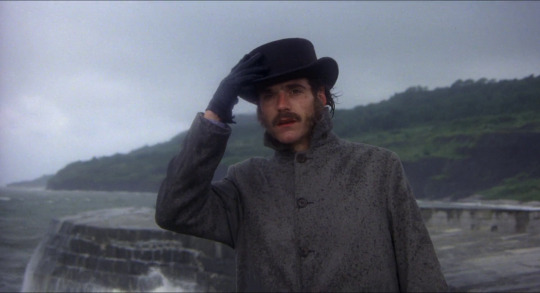

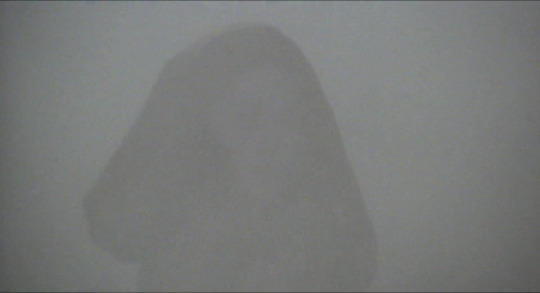
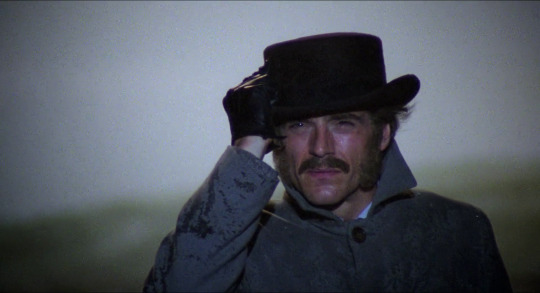


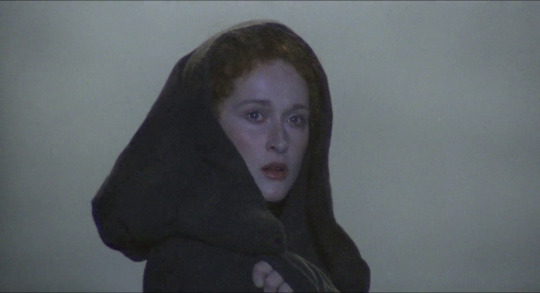

The French Lieutenant's Woman (Karel Reisz, 1981).
#the french lieutenant's woman#karel reisz#jeremy irons#meryl streep#john fowles#harold pinter#freddie francis#john bloom#assheton gorton#allan cameron#norman dorme#terry pritchard#tom rand#ann mollo#the french lieutenant's woman (1981)
156 notes
·
View notes
Photo

Tom Courtenay in The Loneliness of the Long Distance Runner (Tony Richardson, 1962)
Cast: Tom Courtenay, Michael Redgrave, Avis Bunnage, Alec McCowen, James Bolam, Joe Robinson, Dervis Ward, Topsy Jane, Julia Foster. Screenplay: Alan Sillitoe, based on his story. Cinematography: Walter Lassally. Production design: Ralph W. Brinton. Film editing: Antony Gibbs. Music: John Addison.
Tony Richardson's The Loneliness of the Long Distance Runner owes some of its prominence in film history to being grouped with other "Angry Young Men" films, such as Richardson's own Look Back in Anger (1959), Jack Clayton's Room at the Top (1959), Karel Reisz's Saturday Night and Sunday Morning (1960), and Lindsay Anderson's This Sporting Life (1963), working-class dramas that gave a boost to such young actors as Richard Burton, Laurence Harvey, Albert Finney, and Richard Harris. Tom Courtenay also got a leg up on his career, largely because he, more than director Richardson, is what holds The Loneliness of the Long Distance Runner together. Richardson's direction lacks focus and tension. For example, he occasionally resorts to brief bursts of sped-up action that almost make me hear "Yackety Sax" playing in the background. The essence of Alan Sillitoe's screenplay is that, as Kris Kristofferson put it, freedom's just another word for nothing left to lose. Courtenay plays Colin Smith, sent to a reformatory, called a Borstal in Britain, for robbery. The oily, autocratic governor of the institution, played by Michael Redgrave, quickly spots Colin's aptitude for running and grooms him for a race he has arranged between teams from the reform school and an upper-class public school. Colin relishes the illusion of freedom that long-distance running gives him, but when the time comes for the race, he realizes that he's just being used by the governor to enhance his image, so he throws the race at the finish line. The bulk of the film deals with Colin's rebellion against the family in which he grew up, his involvement with a young woman, and the small crimes he and a friend commit before he finally gets caught for the theft. But there's not much shape to the film's flashback integration of this background story, and the film falls slack when it should be building to a climax. Still, Courtenay's performance and solid support from Redgrave, from Alec McCowen as a smarmy school counselor full of hack psychology, and from the fine character actress Avis Bunnage as Colin's mother help keep the film alive.
0 notes
Photo

Book 19-27: 2018 was the year of audiobooks for me. Here’s a look back at all the #lettering I did for each book I listened to.
.
19. Unbelievable: My Front-Row Seat to the Craziest Campaign in American History by Katy Tur
20. The Night Mark by Tiffany Reisz
21. Most of all you by Mia Sheridan
22. New York 2140 by Kim Stanley Robinson
23. The Lucky Ones by Tiffany Reisz
24. Future Home of the Living God by Louise Erdrich
25. Flower for Algernon by Daniel Keys
26. uncommon type by tom hanks
27. Rich People Problems by Kevin Kwan
.
.
.
#sweetsindesign #ipadlettering #autodeskgraphic #lettering #handlettering #handtype #typedesign #typography #design #graphicdesign #booktitledesign #books #procreate #calligraphy
#sweetsindesign#ipad lettering#autodeskgraphic#lettering#hand lettering#hand type#type design#typography#design#graphic design#book title design#books#procreate#calligraphy
0 notes
Text
Review: 'Truth or Dare' (2018)
Review: ‘Truth or Dare’ (2018)
Truth or Dare | Jeff Wadlow | April 13, 2018 (more…)
View On WordPress
#Christopher Roach#Hayden Szeto#Jeff Wadlow#Jillian Jacobs#Landon Liboiron#Lucy Hale#Michael Reisz#Nolan Gerard Funk#Review#Sam Lerner#Sophia Taylor Ali#Tom Choi#Truth or Dare#Tyler Posey#Violett Beane
0 notes
Photo

First buys of 2022! First Apperance of Gambit! The Uncanny X-Men 266 at an 8.0 CGC “Gambit: Out of the frying pan” This book is under rated and it’s a great one to have in your collection! I first had a copy a long time ago and now I have one I can keep 🤩 “Hasn't been your night, eh, chère? Or maybe it has -- considering how often I am here to rescue you.” —Gambit Synopsis for "Gambit: Out of the Frying Pan" In her attempt to steal back some stolen paintings, Ororo has run right into the Shadow King's trap. She desperately struggles against the attacks of his Hounds and, after hurting the King with her haphazard weather power, she falls into a pool, from which she is rescued by a charismatic young thief who calls himself Gambit and has mutant powers himself. Gambit almost manages to mesmerize the King's aide Lian with his charm, but is attacked by the King himself. Together, though, the two thieves manage to trick their attackers and flee via the roof and Storm's parachute.….. WRITER(S) Chris Claremont PENCILER(S) Mike Collins INKER(S) Josef Rubinstein COLORIST(S) Brad Vancata LETTERER(S) Pat Brosseau Tom Orzechowski EDITOR(S) Bob Harras Appearing in "Gambit: Out of the Frying Pan" Featured Characters: * Ororo Supporting Characters: * Gambit (Remy LeBeau) (First full appearance) * Mystique (Raven Darkhölme) Antagonists: * Val Cooper (Possessed by Shadow King) * Dr. Lian Shen (Possessed by Shadow King) * Jacob Reisz (Possessed by Shadow King) * Nanny * Orphan-Maker (Peter) Other Characters: * Unnamed human "Hounds", servants of the Shadow King * Freedom Force (Referenced) * Destiny (Irene Adler)
(Photo) Races and Species: * Humans * Mutants #thecomicsofsolitude #comicsofsolitude #comicbooks #comicbook #comic #comics #marvelcomics #dccomics #actioncomics #marvel #marvelstudios #marvellegends #marveluniverse #stanlee #dc #dcuniverse #dcextendeduniverse #dcfans #marvelfans #love #manofsteel #cgc #superman #instagood #gambit #cosplay #cosplayer #xmen #superhero https://www.instagram.com/p/CYzjYYCPRri/?utm_medium=tumblr
#thecomicsofsolitude#comicsofsolitude#comicbooks#comicbook#comic#comics#marvelcomics#dccomics#actioncomics#marvel#marvelstudios#marvellegends#marveluniverse#stanlee#dc#dcuniverse#dcextendeduniverse#dcfans#marvelfans#love#manofsteel#cgc#superman#instagood#gambit#cosplay#cosplayer#xmen#superhero
0 notes
